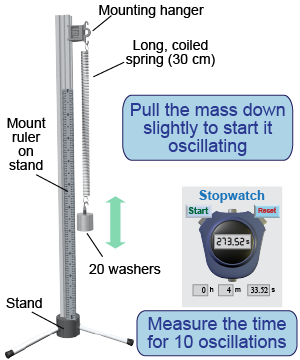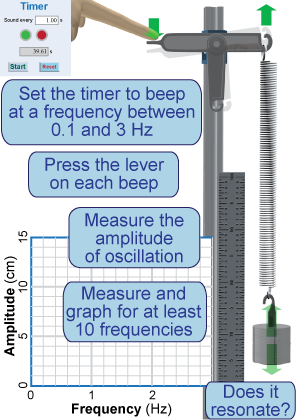|
| Essential questions | | What is resonance? | |
|
When periodic forces are applied to a system that can oscillate, the resulting motion can vary tremendously. If the frequency of the force matches a natural frequency of the system, a very large amplitude response can occur. The extra-large response is what we call resonance. 
|
Part 1: Finding the natural frequency

- Set up the mass hanging from the spring. Use the mounting hanger to attach the spring to the stand.
- Attach a ruler to the stand, centered on the hanging mass.
- Pull the mass down slightly to start it oscillating.
- Measure the time for 10 oscillations.
- What is meant by the oscillator’s “natural frequency”?
- What are the values of your oscillator’s natural period and frequency?
- Describe and then apply a method to estimate the error bars on your frequency measurement.
- Describe the meaning of the terms
phase and amplitude. 
|
|
This electronic stopwatch and timer utility can be used for Parts 1 and 2.
|
Part 2: Creating resonance

- Use the resonance lever to attach the spring and mass to the stand.
- Set the timer to beep at a frequency of between 0.1 and 3 Hz. (Convert between frequency and period first!)
- While using one hand to hold the top of the stand in place, use your other hand to press down on the lever on each beep.
- Have your partner estimate the amplitude of the motion using the ruler.
- Measure and tabulate the oscillation amplitude for at least 10 frequencies ranging between 0.1 Hz and three times the natural frequency. One measurement should be at the frequency you measured in Part 1.
- Graph the oscillation amplitude versus the frequency of the periodic force.
- In your own words, define resonance by referring to the motion you just observed and the graph of your data.
- At what frequencies is the oscillator in resonance? At what frequencies is it out of resonance?
- Describe the flow and storage of energy in the system at resonance compared to frequencies that are not at resonance.
- Prepare a written report for your investigation (Parts 1 and 2). In addition to addressing the above questions, describe the procedure, results, and conclusion (or interpretation) of your investigation.

|

